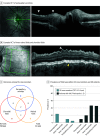Incidence and Progression of Chorioretinal Folds During Long-Duration Spaceflight
- PMID: 36602790
- PMCID: PMC9857718
- DOI: 10.1001/jamaophthalmol.2022.5681
Incidence and Progression of Chorioretinal Folds During Long-Duration Spaceflight
Abstract
Importance: The primary contributing factor for development of chorioretinal folds during spaceflight is unknown. Characterizing fold types that develop and tracking their progression may provide insight into the pathophysiology of spaceflight-associated neuro-ocular syndrome and elucidate the risk of fold progression for future exploration-class missions exceeding 12 months in duration.
Objective: To determine the incidence and presentation of chorioretinal folds in long-duration International Space Station crew members and objectively quantify the progression of choroidal folds during spaceflight.
Design, setting, and participants: In this retrospective cohort study, optical coherence tomography scans of the optic nerve head and macula of crew members completing long-duration spaceflight missions were obtained on Earth prior to spaceflight and during flight. A panel of experts examined the scans for the qualitative presence of chorioretinal folds. Peripapillary total retinal thickness was calculated to identify eyes with optic disc edema, and choroidal folds were quantified based on surface roughness within macular and peripapillary regions of interest.
Interventions or exposures: Spaceflight missions ranging 6 to 12 months.
Main outcomes and measures: Incidence of peripapillary wrinkles, retinal folds, and choroidal folds; peripapillary total retinal thickness; and Bruch membrane surface roughness.
Results: A total of 36 crew members were analyzed (mean [SD] age, 46 [6] years; 7 [19%] female). Chorioretinal folds were observed in 12 of 72 eyes (17%; 6 crew members). In eyes with early signs of disc edema, 10 of 42 (24%) had choroidal folds, 4 of 42 (10%) had inner retinal folds, and 2 of 42 (5%) had peripapillary wrinkles. Choroidal folds were observed in all eyes with retinal folds and peripapillary wrinkles. Macular choroidal folds developed in 7 of 12 eyes (4 of 6 crew members) with folds and progressed with mission duration; these folds extended into the fovea in 6 eyes. Circumpapillary choroidal folds developed predominantly superior, nasal, and inferior to the optic nerve head and increased in prevalence and severity with mission duration.
Conclusions and relevance: Choroidal folds were the most common fold type to develop during spaceflight; this differs from reports in idiopathic intracranial hypertension, suggesting differences in the mechanisms underlying fold formation. Quantitative measures demonstrate the development and progression of choroidal folds during weightlessness, and these metrics may help to assess the efficacy of spaceflight-associated neuro-ocular syndrome countermeasures.
Conflict of interest statement
Figures




Comment in
-
Spaceflight-Associated Neuro-Ocular Syndrome and Increased Intracranial Pressure-Are We Closer to Understanding the Relationship?JAMA Ophthalmol. 2023 Feb 1;141(2):176-177. doi: 10.1001/jamaophthalmol.2022.5686. JAMA Ophthalmol. 2023. PMID: 36602792 No abstract available.
References
Publication types
MeSH terms
Supplementary concepts
LinkOut - more resources
Full Text Sources
Medical

